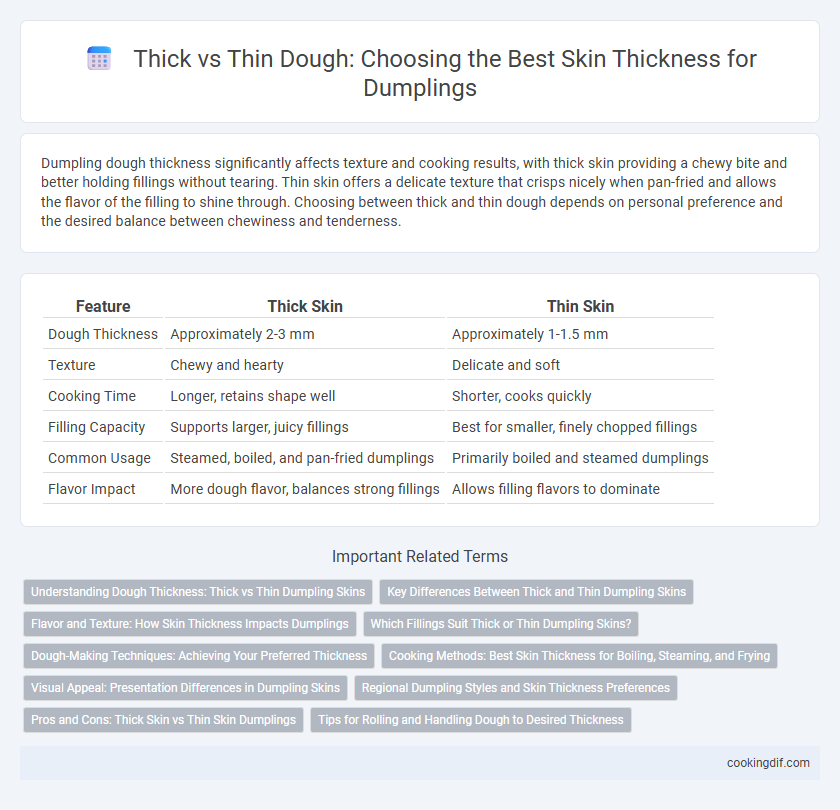Dumpling dough thickness significantly affects texture and cooking results, with thick skin providing a chewy bite and better holding fillings without tearing. Thin skin offers a delicate texture that crisps nicely when pan-fried and allows the flavor of the filling to shine through. Choosing between thick and thin dough depends on personal preference and the desired balance between chewiness and tenderness.
Table of Comparison
| Feature | Thick Skin | Thin Skin |
|---|---|---|
| Dough Thickness | Approximately 2-3 mm | Approximately 1-1.5 mm |
| Texture | Chewy and hearty | Delicate and soft |
| Cooking Time | Longer, retains shape well | Shorter, cooks quickly |
| Filling Capacity | Supports larger, juicy fillings | Best for smaller, finely chopped fillings |
| Common Usage | Steamed, boiled, and pan-fried dumplings | Primarily boiled and steamed dumplings |
| Flavor Impact | More dough flavor, balances strong fillings | Allows filling flavors to dominate |
Understanding Dough Thickness: Thick vs Thin Dumpling Skins
Thick dumpling skins offer a chewy texture that holds robust fillings well, creating a satisfying bite, while thin skins provide a delicate, tender wrapper that highlights the filling's flavor and allows quicker cooking. Choosing between thick and thin skins depends on the desired texture and cooking method, with thick skins ideal for steaming or boiling and thin skins better suited for pan-frying or steaming delicate dumplings like wontons. Mastering dough thickness directly influences the dumpling's overall texture, cooking time, and flavor balance, making it a crucial factor in dumpling preparation.
Key Differences Between Thick and Thin Dumpling Skins
Thick dumpling skins offer a chewy texture and can hold more filling, making them ideal for hearty or meat-heavy dumplings, while thin skins result in a delicate, lighter bite that emphasizes the filling's flavor. Thick skins require longer cooking times to ensure the dough is fully cooked, whereas thin skins cook quickly and offer a tender, almost translucent finish. Choosing between thick and thin dumpling skins depends on the desired balance between dough texture and filling prominence in the final dish.
Flavor and Texture: How Skin Thickness Impacts Dumplings
Thick dumpling skins create a chewier texture that holds fillings firmly, enhancing the overall mouthfeel and allowing rich, juicy flavors to remain inside. Thin skins offer a delicate, tender bite that highlights the filling's freshness and subtle tastes without overwhelming it. Choosing the right dough thickness balances flavor intensity with texture preference, impacting the dumpling's final sensory experience.
Which Fillings Suit Thick or Thin Dumpling Skins?
Thick dumpling skins are ideal for hearty fillings like pork, beef, or mixed vegetables, as they provide durability and hold up well during boiling or steaming. Thin dumpling skins suit delicate fillings such as shrimp, fish, or finely chopped mushrooms, allowing the flavors to shine through without overwhelming the bite. Choosing the appropriate dough thickness enhances texture and flavor balance, ensuring optimal dumpling quality and taste.
Dough-Making Techniques: Achieving Your Preferred Thickness
Thick skin dough creates a chewy and hearty dumpling texture, ideal for containing rich or chunky fillings without breaking. Thin skin dough requires precise rolling techniques to achieve a delicate, translucent wrapper that cooks quickly and highlights the filling's flavor. Mastering dough elasticity and hydration levels helps maintain structural integrity regardless of thickness preference in dumpling-making.
Cooking Methods: Best Skin Thickness for Boiling, Steaming, and Frying
Thick dumpling skins hold up well during boiling, preventing tearing and retaining filling juices, making them ideal for soup dumplings and hearty fillings. Thin skins cook faster and become tender during steaming, offering a delicate texture suited for lighter, finely minced fillings. For frying, medium-thick skins balance crispiness and chewiness, creating the perfect golden crust without sogginess or burning.
Visual Appeal: Presentation Differences in Dumpling Skins
Thick skin dumplings showcase a hearty, rustic appearance with a visibly dense, doughy texture that holds fillings securely, enhancing a comforting visual appeal. Thin skin dumplings present a delicate, translucent look, allowing the vibrant colors of the filling to subtly show through, creating an elegant and refined presentation. The choice between thick and thin dough skins significantly influences the dumpling's visual texture and overall aesthetic impact on the plate.
Regional Dumpling Styles and Skin Thickness Preferences
Regional dumpling styles exhibit distinct preferences for dough thickness, with northern Chinese dumplings often featuring thick, chewy skins to hold hearty fillings, while southern varieties favor thin, delicate wrappers that emphasize texture and subtlety. In Japanese gyoza, the skin is typically thin and tender, allowing quick cooking and a crispy finish, whereas Russian pelmeni use thicker dough to withstand boiling without breaking. These differences reflect cultural tastes and cooking methods, influencing the balance between dough elasticity and filling prominence in each dumpling tradition.
Pros and Cons: Thick Skin vs Thin Skin Dumplings
Thick skin dumplings offer a chewy texture and better structural integrity, making them ideal for stuffing with juicy or heavy fillings, but they can sometimes overshadow delicate flavors. Thin skin dumplings provide a lighter, more tender bite that highlights the fillings' freshness and subtlety, although they are more prone to tearing during cooking. Choosing between thick and thin skin depends on the desired balance between texture durability and flavor prominence in the final dish.
Tips for Rolling and Handling Dough to Desired Thickness
For perfectly rolled dumpling dough, maintain an even pressure with a rolling pin to achieve a consistent thickness, whether thick or thin. Use a floured surface to prevent sticking and gently rotate the dough frequently to ensure uniform thickness across the circle. Thin skins require delicate handling to avoid tearing, while thick skins benefit from slightly firmer pressure to keep the dough pliable and chewy.
Thick skin vs Thin skin for dough thickness Infographic

 cookingdif.com
cookingdif.com